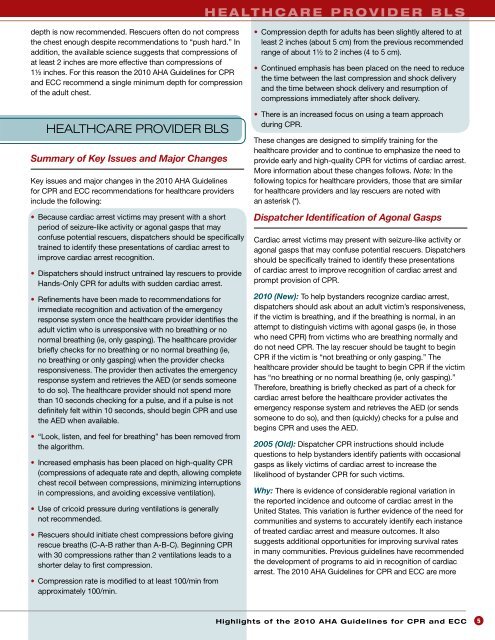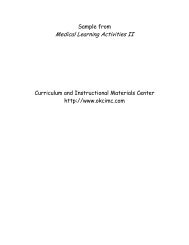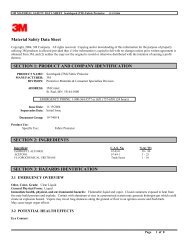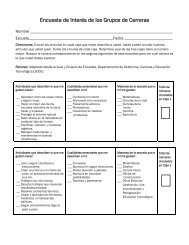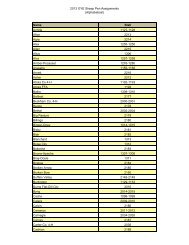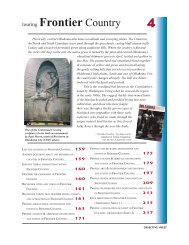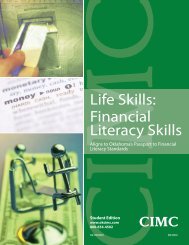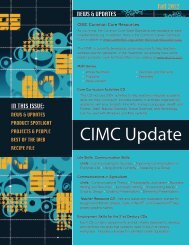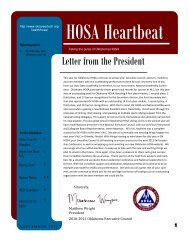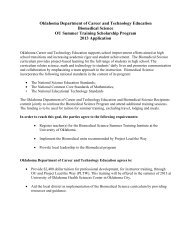Highlights of the 2010 Guidelines for CPR and ECC - ECC Guidelines
Highlights of the 2010 Guidelines for CPR and ECC - ECC Guidelines
Highlights of the 2010 Guidelines for CPR and ECC - ECC Guidelines
You also want an ePaper? Increase the reach of your titles
YUMPU automatically turns print PDFs into web optimized ePapers that Google loves.
H e a lt h C a r e P r o v i d e r b l s<br />
depth is now recommended. Rescuers <strong>of</strong>ten do not compress<br />
<strong>the</strong> chest enough despite recommendations to “push hard.” In<br />
addition, <strong>the</strong> available science suggests that compressions <strong>of</strong><br />
at least 2 inches are more effective than compressions <strong>of</strong><br />
1½ inches. For this reason <strong>the</strong> <strong>2010</strong> AHA <strong>Guidelines</strong> <strong>for</strong> <strong>CPR</strong><br />
<strong>and</strong> <strong>ECC</strong> recommend a single minimum depth <strong>for</strong> compression<br />
<strong>of</strong> <strong>the</strong> adult chest.<br />
HEALTHCARE PROVIDER BLS<br />
Summary <strong>of</strong> Key Issues <strong>and</strong> Major Changes<br />
Key issues <strong>and</strong> major changes in <strong>the</strong> <strong>2010</strong> AHA <strong>Guidelines</strong><br />
<strong>for</strong> <strong>CPR</strong> <strong>and</strong> <strong>ECC</strong> recommendations <strong>for</strong> healthcare providers<br />
include <strong>the</strong> following:<br />
• Because cardiac arrest victims may present with a short<br />
period <strong>of</strong> seizure-like activity or agonal gasps that may<br />
confuse potential rescuers, dispatchers should be specifically<br />
trained to identify <strong>the</strong>se presentations <strong>of</strong> cardiac arrest to<br />
improve cardiac arrest recognition.<br />
• Dispatchers should instruct untrained lay rescuers to provide<br />
H<strong>and</strong>s-Only <strong>CPR</strong> <strong>for</strong> adults with sudden cardiac arrest.<br />
• Refinements have been made to recommendations <strong>for</strong><br />
immediate recognition <strong>and</strong> activation <strong>of</strong> <strong>the</strong> emergency<br />
response system once <strong>the</strong> healthcare provider identifies <strong>the</strong><br />
adult victim who is unresponsive with no breathing or no<br />
normal breathing (ie, only gasping). The healthcare provider<br />
briefly checks <strong>for</strong> no breathing or no normal breathing (ie,<br />
no breathing or only gasping) when <strong>the</strong> provider checks<br />
responsiveness. The provider <strong>the</strong>n activates <strong>the</strong> emergency<br />
response system <strong>and</strong> retrieves <strong>the</strong> AED (or sends someone<br />
to do so). The healthcare provider should not spend more<br />
than 10 seconds checking <strong>for</strong> a pulse, <strong>and</strong> if a pulse is not<br />
definitely felt within 10 seconds, should begin <strong>CPR</strong> <strong>and</strong> use<br />
<strong>the</strong> AED when available.<br />
• “Look, listen, <strong>and</strong> feel <strong>for</strong> breathing” has been removed from<br />
<strong>the</strong> algorithm.<br />
• Increased emphasis has been placed on high-quality <strong>CPR</strong><br />
(compressions <strong>of</strong> adequate rate <strong>and</strong> depth, allowing complete<br />
chest recoil between compressions, minimizing interruptions<br />
in compressions, <strong>and</strong> avoiding excessive ventilation).<br />
• Use <strong>of</strong> cricoid pressure during ventilations is generally<br />
not recommended.<br />
• Rescuers should initiate chest compressions be<strong>for</strong>e giving<br />
rescue breaths (C-A-B ra<strong>the</strong>r than A-B-C). Beginning <strong>CPR</strong><br />
with 30 compressions ra<strong>the</strong>r than 2 ventilations leads to a<br />
shorter delay to first compression.<br />
• Compression rate is modified to at least 100/min from<br />
approximately 100/min.<br />
• Compression depth <strong>for</strong> adults has been slightly altered to at<br />
least 2 inches (about 5 cm) from <strong>the</strong> previous recommended<br />
range <strong>of</strong> about 1½ to 2 inches (4 to 5 cm).<br />
• Continued emphasis has been placed on <strong>the</strong> need to reduce<br />
<strong>the</strong> time between <strong>the</strong> last compression <strong>and</strong> shock delivery<br />
<strong>and</strong> <strong>the</strong> time between shock delivery <strong>and</strong> resumption <strong>of</strong><br />
compressions immediately after shock delivery.<br />
• There is an increased focus on using a team approach<br />
during <strong>CPR</strong>.<br />
These changes are designed to simplify training <strong>for</strong> <strong>the</strong><br />
healthcare provider <strong>and</strong> to continue to emphasize <strong>the</strong> need to<br />
provide early <strong>and</strong> high-quality <strong>CPR</strong> <strong>for</strong> victims <strong>of</strong> cardiac arrest.<br />
More in<strong>for</strong>mation about <strong>the</strong>se changes follows. Note: In <strong>the</strong><br />
following topics <strong>for</strong> healthcare providers, those that are similar<br />
<strong>for</strong> healthcare providers <strong>and</strong> lay rescuers are noted with<br />
an asterisk (*).<br />
Dispatcher Identification <strong>of</strong> Agonal Gasps<br />
Cardiac arrest victims may present with seizure-like activity or<br />
agonal gasps that may confuse potential rescuers. Dispatchers<br />
should be specifically trained to identify <strong>the</strong>se presentations<br />
<strong>of</strong> cardiac arrest to improve recognition <strong>of</strong> cardiac arrest <strong>and</strong><br />
prompt provision <strong>of</strong> <strong>CPR</strong>.<br />
<strong>2010</strong> (New): To help byst<strong>and</strong>ers recognize cardiac arrest,<br />
dispatchers should ask about an adult victim’s responsiveness,<br />
if <strong>the</strong> victim is breathing, <strong>and</strong> if <strong>the</strong> breathing is normal, in an<br />
attempt to distinguish victims with agonal gasps (ie, in those<br />
who need <strong>CPR</strong>) from victims who are breathing normally <strong>and</strong><br />
do not need <strong>CPR</strong>. The lay rescuer should be taught to begin<br />
<strong>CPR</strong> if <strong>the</strong> victim is “not breathing or only gasping.” The<br />
healthcare provider should be taught to begin <strong>CPR</strong> if <strong>the</strong> victim<br />
has “no breathing or no normal breathing (ie, only gasping).”<br />
There<strong>for</strong>e, breathing is briefly checked as part <strong>of</strong> a check <strong>for</strong><br />
cardiac arrest be<strong>for</strong>e <strong>the</strong> healthcare provider activates <strong>the</strong><br />
emergency response system <strong>and</strong> retrieves <strong>the</strong> AED (or sends<br />
someone to do so), <strong>and</strong> <strong>the</strong>n (quickly) checks <strong>for</strong> a pulse <strong>and</strong><br />
begins <strong>CPR</strong> <strong>and</strong> uses <strong>the</strong> AED.<br />
2005 (Old): Dispatcher <strong>CPR</strong> instructions should include<br />
questions to help byst<strong>and</strong>ers identify patients with occasional<br />
gasps as likely victims <strong>of</strong> cardiac arrest to increase <strong>the</strong><br />
likelihood <strong>of</strong> byst<strong>and</strong>er <strong>CPR</strong> <strong>for</strong> such victims.<br />
Why: There is evidence <strong>of</strong> considerable regional variation in<br />
<strong>the</strong> reported incidence <strong>and</strong> outcome <strong>of</strong> cardiac arrest in <strong>the</strong><br />
United States. This variation is fur<strong>the</strong>r evidence <strong>of</strong> <strong>the</strong> need <strong>for</strong><br />
communities <strong>and</strong> systems to accurately identify each instance<br />
<strong>of</strong> treated cardiac arrest <strong>and</strong> measure outcomes. It also<br />
suggests additional opportunities <strong>for</strong> improving survival rates<br />
in many communities. Previous guidelines have recommended<br />
<strong>the</strong> development <strong>of</strong> programs to aid in recognition <strong>of</strong> cardiac<br />
arrest. The <strong>2010</strong> AHA <strong>Guidelines</strong> <strong>for</strong> <strong>CPR</strong> <strong>and</strong> <strong>ECC</strong> are more<br />
<strong>Highlights</strong> <strong>of</strong> <strong>the</strong> <strong>2010</strong> AHA <strong>Guidelines</strong> <strong>for</strong> <strong>CPR</strong> <strong>and</strong> <strong>ECC</strong><br />
5


